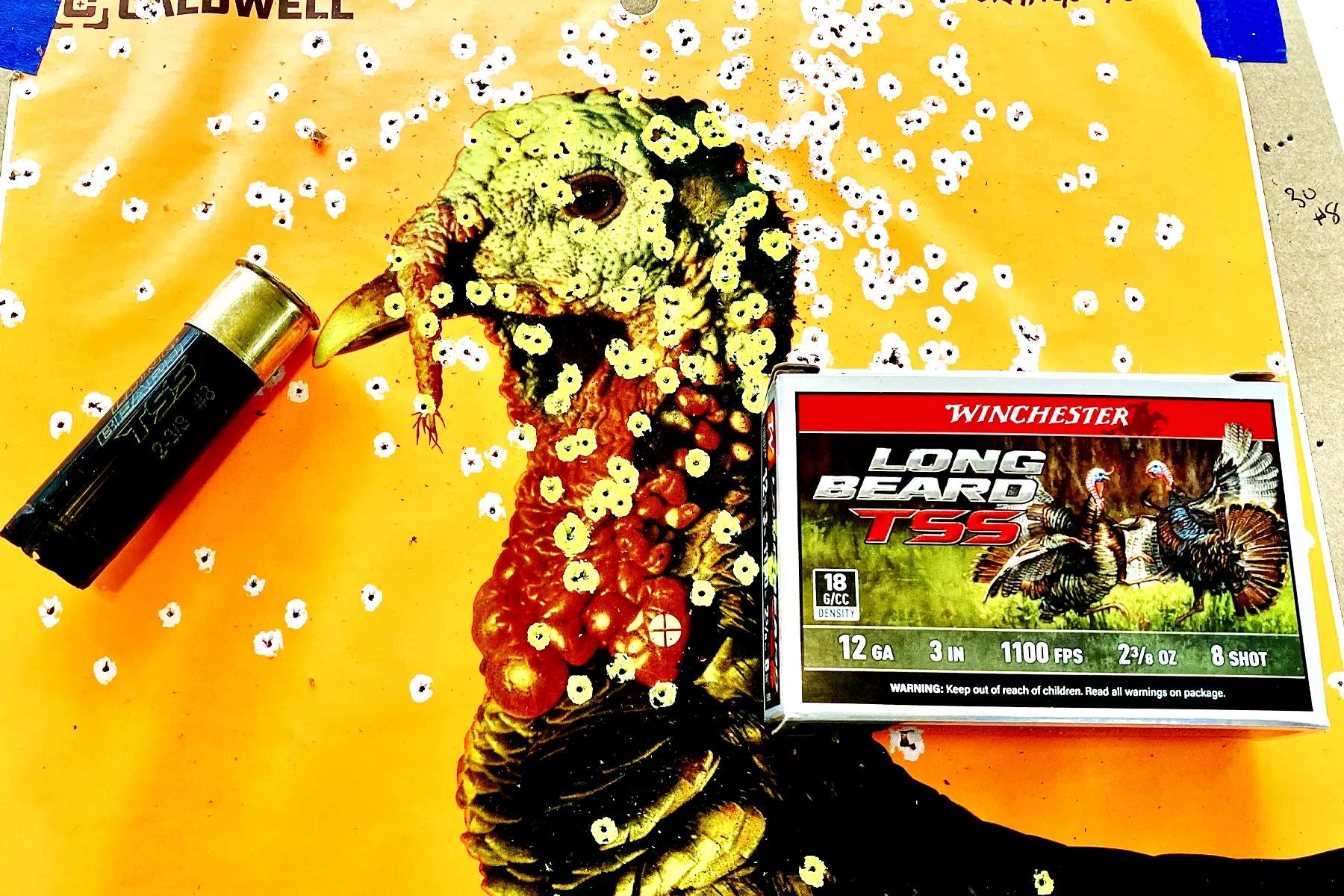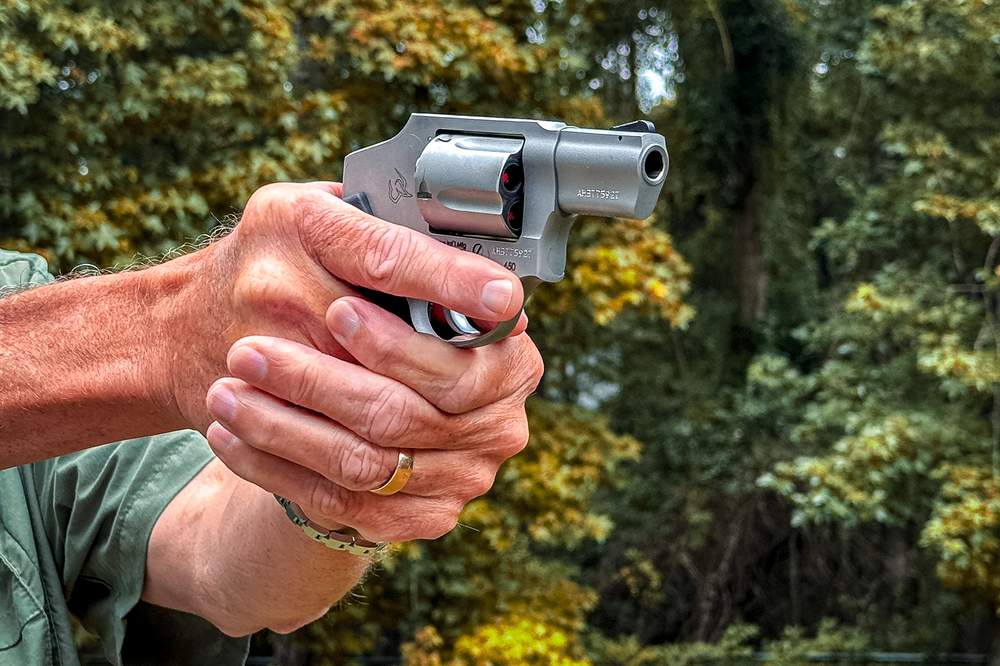Drop More Birds At Greater Distances With Winchester’s New Tungsten Shot
At 20 yards, my first two shots of Winchester’s new Long Beard TSS turkey hunting shells just obliterated the head of the turkey target. A fist-sized group of No. 8 tungsten pellets punched that head, with the shotshell wad following the pellets for a little extra smack.
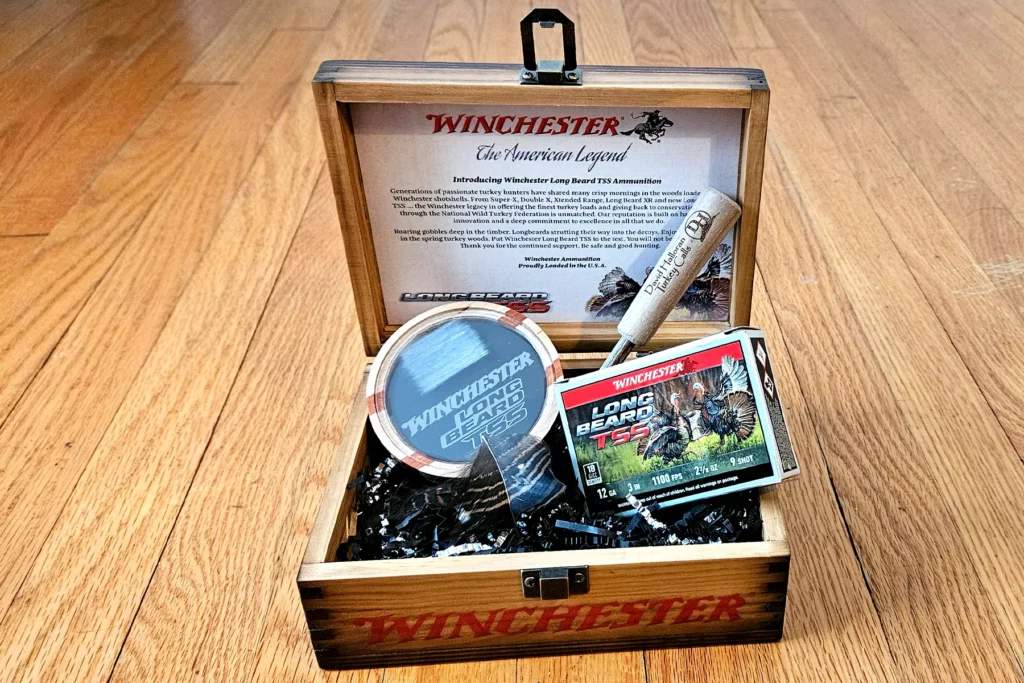
Yes, 20 yards is very close. But, damn, I thought to myself, that was the first time a turkey load produced a headless tom at 20 yards!
I backed up to 30 yards and ran the Long Beard TSS load, and the patterns got wider. But no tom was living through that. At 45 yards? Turkey dinner.

Of course, some of the credit for these patterns goes to my Beretta 300 Ultima Turkey shotgun and the reflex optic I mounted. Still, I haven’t seen these kinds of tight clusters at these distances before, and I’ve run a good number of turkey hunting shells over the last decade, including those loaded with tungsten pellets.
Behind The Success Of Winchester’s Long Beard TSS
Winchester introduced the original Long Beard offerings years ago, but in lead-pellet loads.
With Long Beard TSS, Winchester substantially increased the effective range of the Long Beard line with very tight patterns and hard-hitting tungsten pellets. Long Beard TSS shells are available in 12-gauge, 20-gauge, 28-gauge, and .410 bore. Winchester’s Buffered Payload design allows the shot to flow smoothly through any choke size, eliminating flyers for longer-range pattern density.
The shells are loaded with the densest tungsten shot available, 18 g/cc, compared to the lighter lead at 11.2 g/cc. With this density factor, the Long Beard TSS pellets can be smaller than their lead counterparts and still deliver equal or even better lethality than lead.
Smaller TSS pellets also mean that TSS shells have higher shot counts per shell compared to shells of the same length loaded with larger lead pellets. In some cases, TSS shells loaded with No. 8 and 9 pellets can hold up to double the pellets in the sized lead turkey shells filled with No. 4, 5, or 6 shot.
For example, a 12-gauge, 3-inch turkey shell loaded with No. 5 lead shot holds approximately 332 pellets. But a 12-gauge, 3-inch Long Beard TSS No. 8 packs some 598 tungsten pellets, while the No. 9 holds an astounding 852 turkey-killing pellets.
More pellets equal denser patterns equal more big toms hitting the ground.
Winchester testing found that the two Long Beard TSS shells I used can place six to 10 times the number of pellets in a 10-inch circle at 60 yards, compared with the traditional 3-inch lead turkey load with No. 5 shot referenced above.
And those No. 8 and 9 TSS pellets hit with five times the energy at the 60-yard mark!
Beretta A300 Ultima Turkey With Viridian Optic
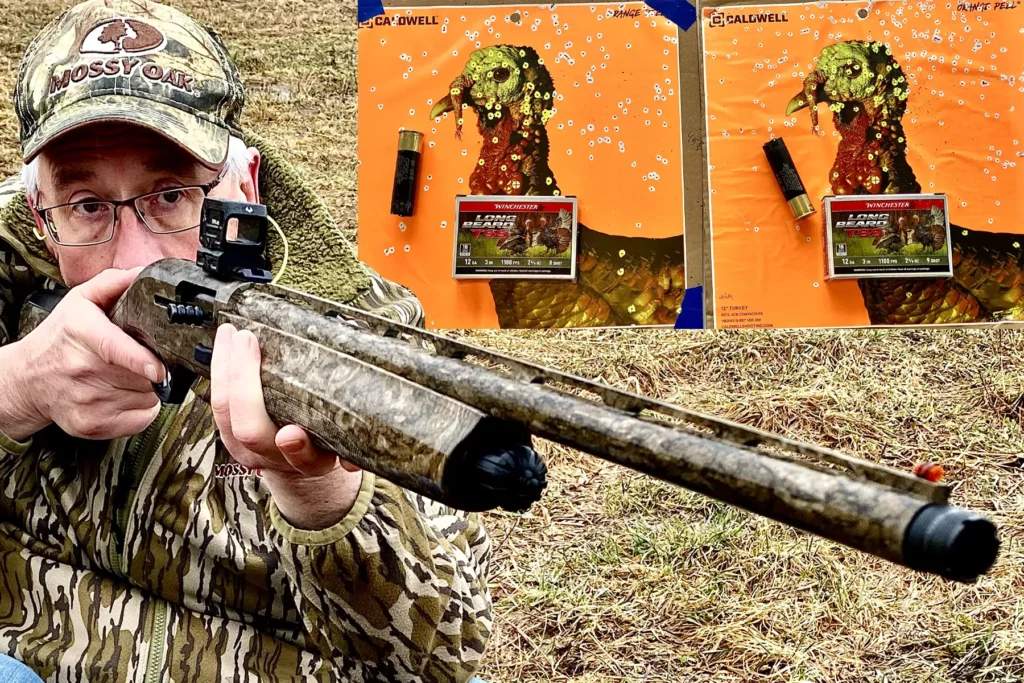
For testing and evaluation, I received boxes of Long Beard TSS in 3-inch 12-gauge shells. Half my shells were loaded with No. 8 tungsten pellets, the other half with No. 9 tungsten pellets. Both options held 2 3/8 ounces of their respective pellets.
For my test, I ran a Beretta A300 Ultima Turkey shotgun finished in Mossy Oak Bottomland pattern. The latest addition to the gun maker’s reliable A300 shotgun series, the semi-automatic shotgun featured a 28-inch barrel, a red fiber optic front bead, and Beretta’s Kick-Off recoil reduction system.
The Ultima also sported a larger bolt handle and bolt release than other models for easy manipulation in adverse conditions. Both were a real plus in my shooting, which was done on a 32-degree morning with a 10-plus mile per hour wind from my left to right, and a cold, misty rain blowing over me and the shotgun.
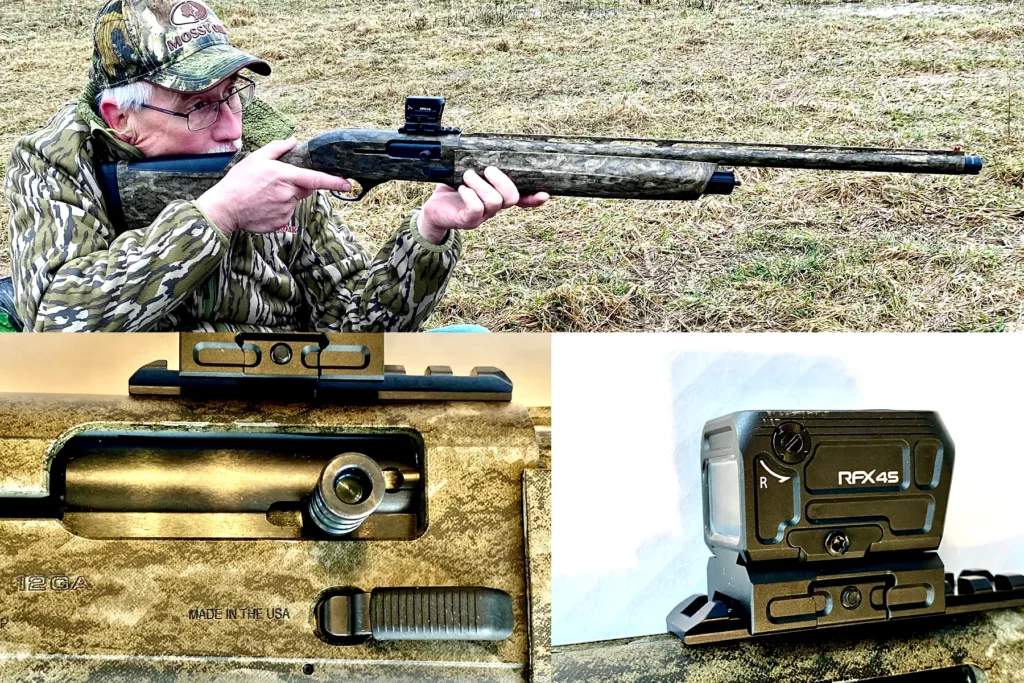
I mounted an RFX45 Closed Emitter Green Dot Reflex Sight, made by Viridian Weapon Technologies. The green MOA dot worked great for my eyes, which tend to make the red dot in a red dot optic flare. With the RFX 45, the green dot was tight and sharp-edged.
The RFX 45 also featured a machined 6061 aluminum housing, fully multi-coated lenses, INSTANT-ON activation and auto shut off, and a 50,000-hour battery life. The optic included numerous mounts and adapter plates, so the optic easily affixed to the rail atop the shotgun’s receiver.
Winchester Long Beard TSS Test Results
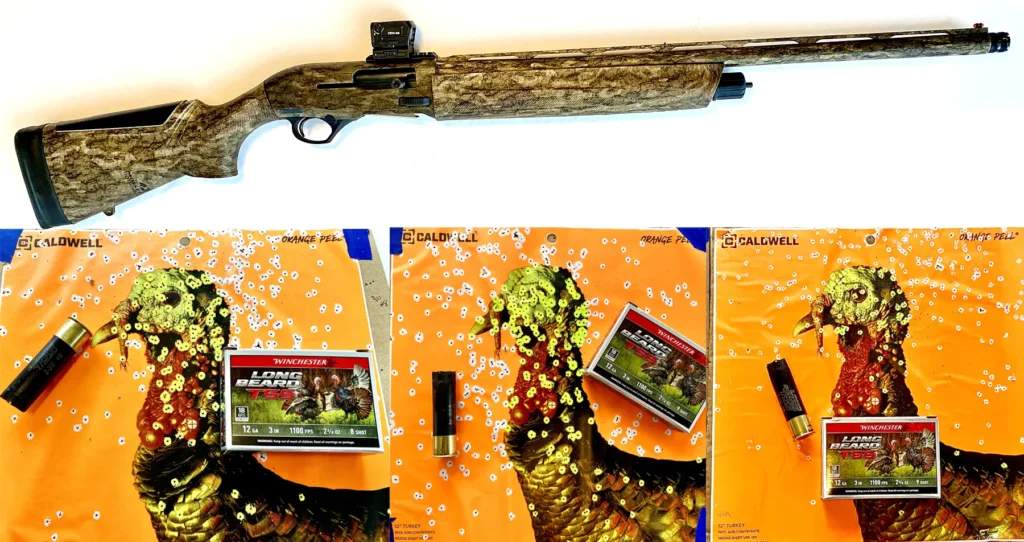
I shot from a low hunting seat, the one I actually use for my turkey hunting, with the shotgun resting on a two-legged Trigger Stick or using my elbows and knees for steadier shooting.
My “toms” were Caldwell Orange Peel 12-inch Turkey targets. The bright orange background lit up really well on the overcast, misty day of my testing, while pellet hits on the facsimile bird’s head and neck popped bright yellow.
I zeroed the RFX 45 using standard 12-gauge target shells and, once ready, loaded up with the Long Beard TSS 3-inch shells. As noted, the 20-yard shooting provided devastating patterns.
At 30 yards, both the No. 8 and No. 9 TSS loads easily placed 25 to 35 pellets into the head and neck areas of the targets. The top pattern at this distance produced an amazing 48 hits.
Next, I moved onto 45 yards, and the two loads made between 15 and 20 hits to the kill zone.
The tight TSS patterns provided a kind of insurance policy at the 45-yard mark, too, I noticed. On one of my shots, using the No. 9 pellet load, the center of the pattern clearly drilled the target a few inches up and to the right of the bird’s head. However, the head and neck still recorded 20 lethal hits!
And for all the distances I shot, I did not count every hit to the head and neck. I only tabulated those at or near the lethal center areas.
One major thing to consider about this test is that I ran the Beretta shotgun with the already-installed full choke tube, not the extra full one. That makes the tight Long Beard TSS patterns I achieved more impressive.
Other Winchester Long Beard TSS Options

Long Beard TSS is available in eight different options, including a 3.5-inch 12-gauge option loaded with 2 ¾ ounces of No. 8 tungsten pellets and the two 12-gauge loads I tested. Winchester also offers a pair of Long Beard TSS offerings in both 20- and 28-gauge, and a 3.0-inch .410 bore load carrying 13/16ths of an ounce of No. 9 pellets.
Pricey? Oh, yes. That’s the tungsten reality for all ammunition manufacturers, as this heavy metal is a costly commodity.
But then I think of the money I have wrapped up in a turkey-hunting shotgun, camouflage, calls, binoculars, packs, and other gear. At that point, the price per shell seems to me a relatively small investment to greatly increase my odds of bagging a big tom turkey, especially the ones that tend to hang back beyond the 30-paces range.
